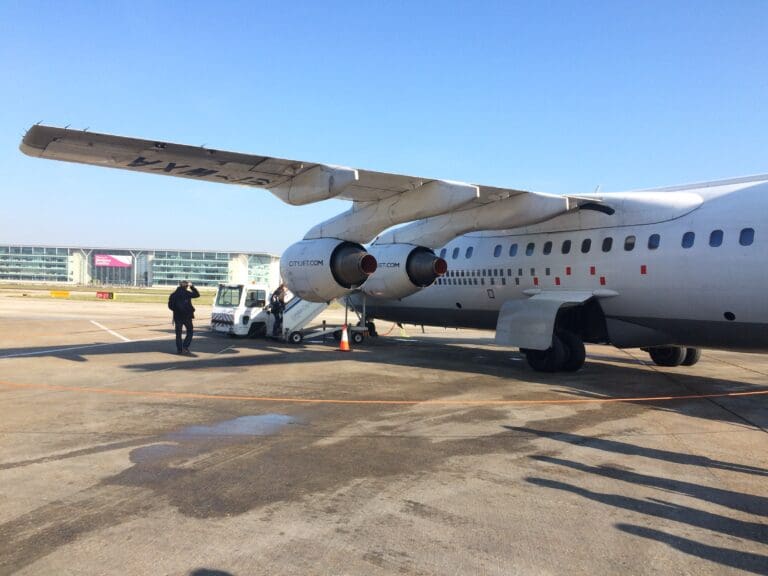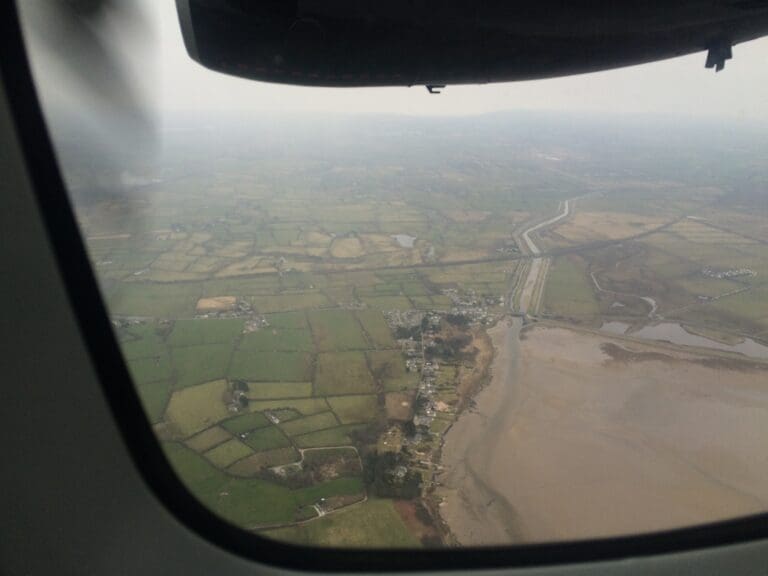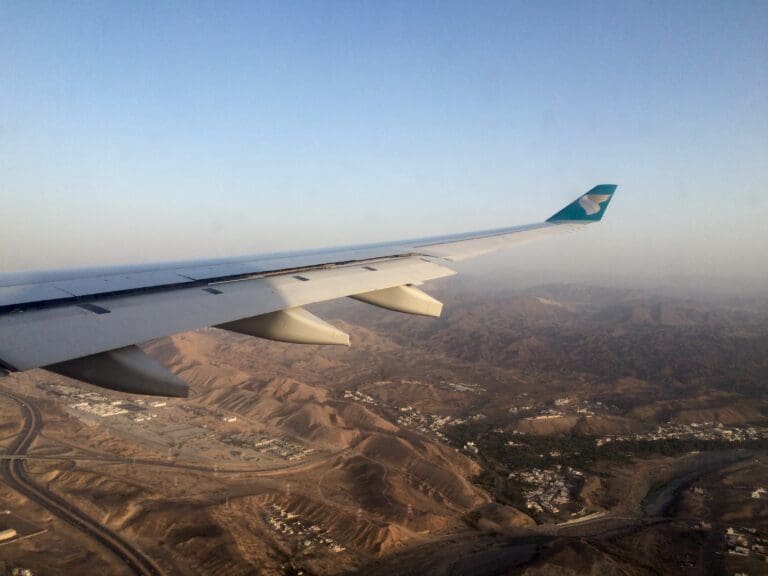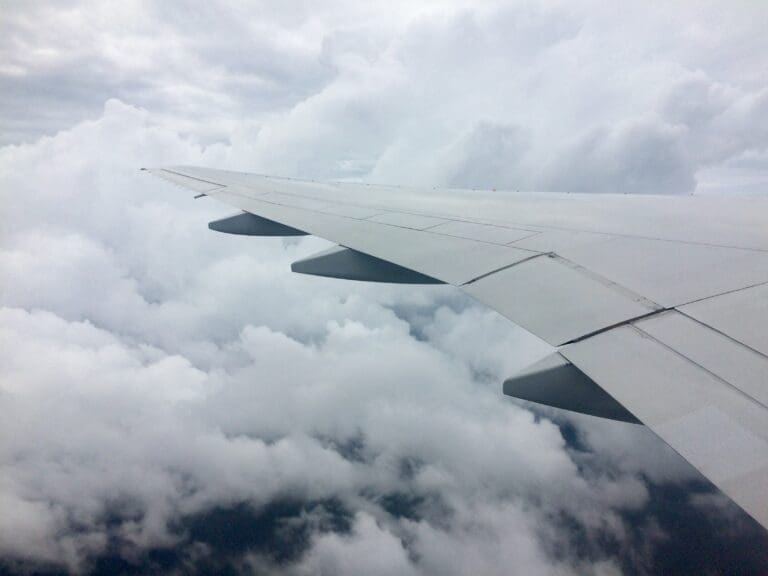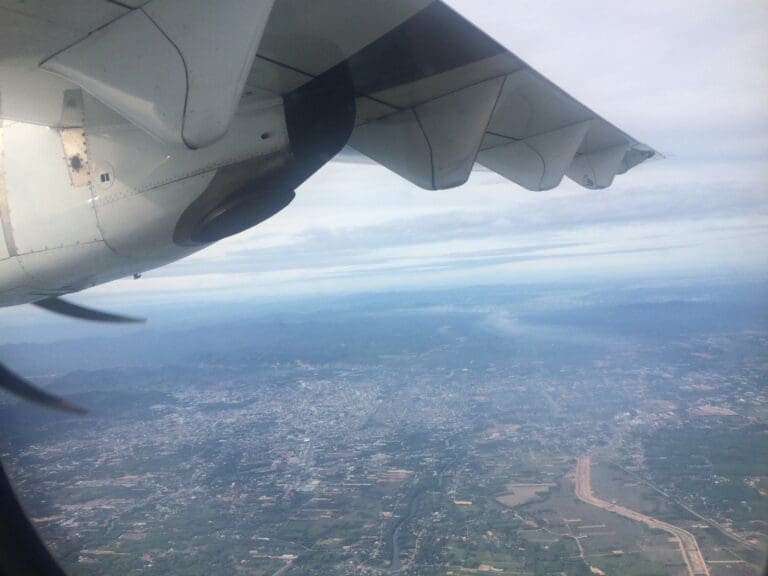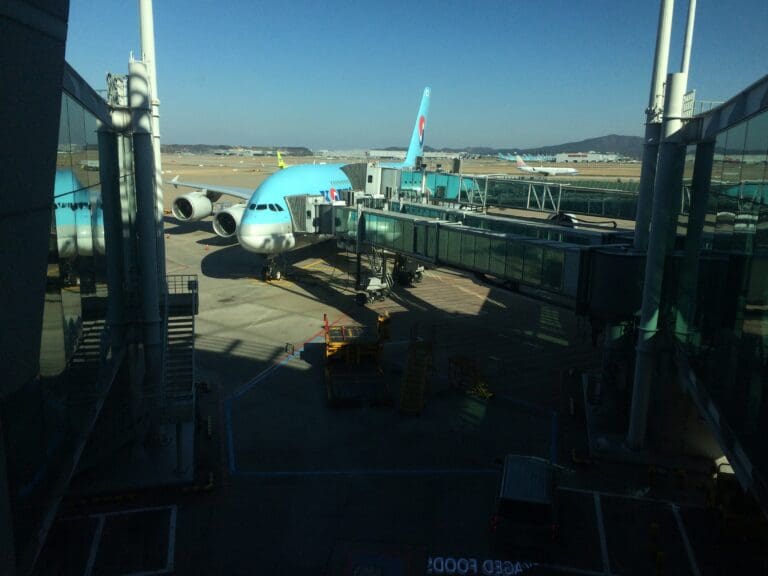Shandong Airlines Review: Flying from Seoul Incheon to Yantai
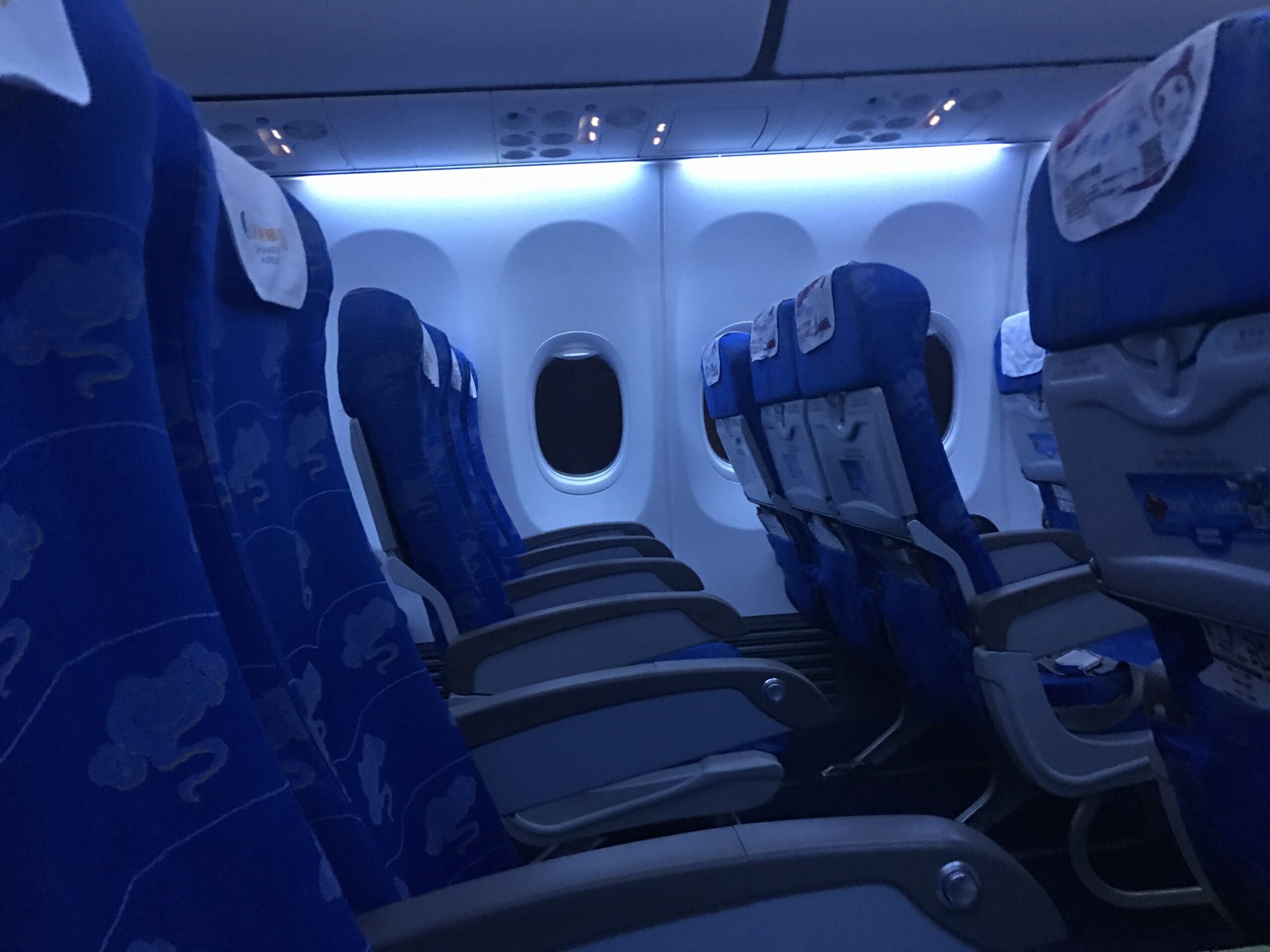
The Basics
| Full Itinerary | ICN-YNT-ICN | |||
| Route Competitors | Asiana Airlines China Eastern Airlines | |||
| Inclusions | 1 x hand luggage | 55cm x 40cm x 20cm | ||
| 1 x personal item | Briefcase/Handbag | |||
| 1 x hold luggage | 20kg | |||
My Expectations
| Skytrax Star Rating | Skytrax Customer Review Rating | Trip Advisor Score | TrustPilot Score |
| 3* | 5/10 | 3.5 / 5 | N/A |
| No of Flights with Shandong Airlines | Last Flight Date | Previous Flights with Shandong Airlines | |
| 0 | N/A | N/A | |
| Expectation | Average | ||
| Expectation Reasoning | |||
| Before embarking on my Shandong Airlines adventure, I was unable to find many reviews of the airline online and so I entered this trip with an open mind. | |||
Background and Booking
After deciding to fly on the elusive Xi’an MA60 through the skies of northeastern China, I needed to find a cheap way to position myself across the Yellow Sea to the coastal Shandong city of Yantai from where I would start my Modern Ark Adventure. Fortunately, thanks to the significant levels of trade and business interaction between Shandong and Korea, no fewer than three airlines plough the 301-mile route between Seoul Incheon and Yantai. On a side note, this is one of the shortest routes between Korea and China, only eclipsed by the routes to Dalian and Weihei. Travelling on a budget and given the short flight duration, I decided there to be little harm in going for the cheapest option. Keeping things regionally appropriate, this ended up being Shandong Airlines’ late Friday night departure from Incheon. This ended up aligning very well with my schedule and would enable me to enjoy almost 48 hours in China before returning to Korea on Sunday evening.
Naturally, I would have liked to book tickets directly with Shandong Airlines, however, as anyone who has ever flown with a Chinese carrier will know, booking tickets from abroad with a carrier that isn’t Air China, China Eastern Airlines, China Southern Airlines or Xiamen Air is usually an impossibility. Whilst I made it as far as Shandong Airlines’ website, seeing as this was only available in Chinese I decided to retreat and instead booked my ticket with Chinese booking platform, Ctrip, instead. Fortunately, this enabled me to book my return flights between Incheon and Yantai without any difficulty and I received my booking confirmation and receipt almost instantly.
Coincidentally, this would be my second time flying from Seoul Incheon to Yantai in the space of a few weeks, having previously flown the route with China Eastern Airlines. Therefore, I was looking forward to seeing how the service onboard varied compared to that of one of China’s largest airlines.
About Shandong Airlines
If you live outside of East Asia, you can be forgiven for not being too familiar with the operations of Chinese carrier Shandong Airlines. Established to improve regional connectivity, in 1994 the airline operated its first service between its base in Jinan, the capital of Shandong Province, and the region’s former capital, Jining. Initially flying the Antonov An-24 derived Xi’an Y-7, these were soon replaced by four comparatively modern and efficient Saab 340 turboprops, whilst a fleet of Boeing 737-300s was also soon added. Growing its route network to encompass destinations across China, more aircraft were soon added and in 2000, the first of fourteen Bombardier CRJ-200s joined Shandong Airlines’ fleet. In 2004, the airline operated its first international service and the following year, the first of the airline’s brand-new Boeing 737NGs touched down in China. As of the time of my trip, Shandong Airlines operates a whopping fleet of 96 Boeing 737-800s, 3 Boeing 737-700s and 2 Bombardier CRJ-700s, although the latter two types are soon to be withdrawn from service. Meanwhile, the airline has 34 Boeing 737 MAX 8s and 10 COMAC ARJ21-700s on its order books.
The Journey
Thanks to the less enjoyable side of university life, the two weeks that separated booking the trip and my departure day were long and, in part, stressful. After seemingly endless days whereby time seemed to pass at a quarter of its usual rate thanks to a mixture of exams coupled with less-than-interesting lectures, peppered with long nights of essay writing, my departure day finally arrived. On a more positive note, during these two weeks, the freezing Korean winter temperatures faded away bringing an end to the snow and ice, heralding the commencement of spring. Considering my flight’s evening departure time, thankfully no early wake-up was needed and instead, I spent the day doing various activities that I had neglected over the previous couple of weeks such as tidying my flat and cooking food that was neither ramen nor microwavable.
Following a productive yet relaxing day, I squeezed everything that I would need for the weekend into my backpack before slinging my hook and making my way out onto the streets of Seoul at about 1700. Living on the west side of the city, as is usually the case, I saw no reason not to use Korail’s all-stop Airport Railroad Express service to reach the airport, more commonly known as AREX. Soon, I reached the tall and modern surrounds of Seoul’s media hub, Digital Media City, where I descended downwards, tapped my T-Money card on the barriers and made my way to the westbound AREX platforms. Having inadvertently timed things just right, once there it wasn’t long before the next Incheon Airport-bound Hyundai Rotem train came hurtling into the platform. Seeing as I was travelling during the evening rush, and considering that this service not only connects Seoul to Incheon Airport but also serves many of the satellite towns to the west of Seoul, thereby serving as an important commuter service.
From Digital Media City, the train soon sped out of Seoul and entered the open air, whizzing over the Han River before temporarily heading back underground and making a stop at Gimpo Airport. After reaching Gyeyang, I managed to find a seat and spent the remaining thirty or so minutes enjoying the luxury of a firm subway-style seat. Following a few more stops, the train soared over the mudflats that separate the Korean mainland from Yeongjeong Island, before we made our final sprint towards the Incheon Airport. Around fifty minutes after leaving Digital Media City, the train came to a halt at its terminus before the doors slid open and the mixture of suitcase-wielding flyers and airport staff disembarked. Once off the train, I made my way up the long flight of escalators and tapped out of the station before continuing into the airport’s spacious ground transport hub, home to, amongst other things, a cinema, several cafés and a restaurant. Not wishing to stop to grab anything to eat or drink, I continued onwards and soon found myself in Incheon Airport’s massive and modern check-in hall.
Despite there being plenty of flights departing to destinations across the world, that evening the check-in hall was calm and pleasant. Furthermore, this was as clean and tidy as ever, and I was left with nothing to complain about as I wandered through this. Meanwhile, on the stage in the grand atrium, a team of Chinese martial arts experts appeared to be entertaining a crowd of mostly elderly Koreans on plastic chairs, wowing them with some impressive stunts and manoeuvres. As I have found to be the case with all Chinese airlines, whilst Shandong Airlines does offer an online check-in service, I was unable to use this and thus whilst lacking any hold luggage, I was still required to stop by at Shandong Airlines’ check-in counters in order to check-in and pick up my boarding pass.
Upon checking the departure boards, I found that Shandong Airlines’ check-in desks for their three evening services to Jinan, Qingdao and Yantai were located at the ‘H’ check-in island. However, with these not opening until 1840, I ended up having a free twenty minutes to linger around before these opened. Owing to that day’s good weather and clear conditions, I decided to make my way outside and spent five minutes watching the stream of aircraft approaching Runway 34. These consisted of a Silk Way West Airlines Boeing 747-8 Freighter which had trekked across Asia from its base in Baku, alongside two locally based Korean Air widebody jets – an Airbus A330-200 and a Boeing 777-300ER. Once I had soaked up the last of that day’s sunshine, I made my way back into the terminal and soon arrived at Shandong Airlines’ check-in desks. Given the fact that Shandong Airlines would have three flights departing in quick succession, I somewhat expected to be presented with long queues. However, much to my delight, this was not the case, and the queue for the airline’s check-in desks was limited to no more than a large family and two couples. This was a complete contrast to my China Eastern Airlines check-in experience when heading to Yantai a month prior!
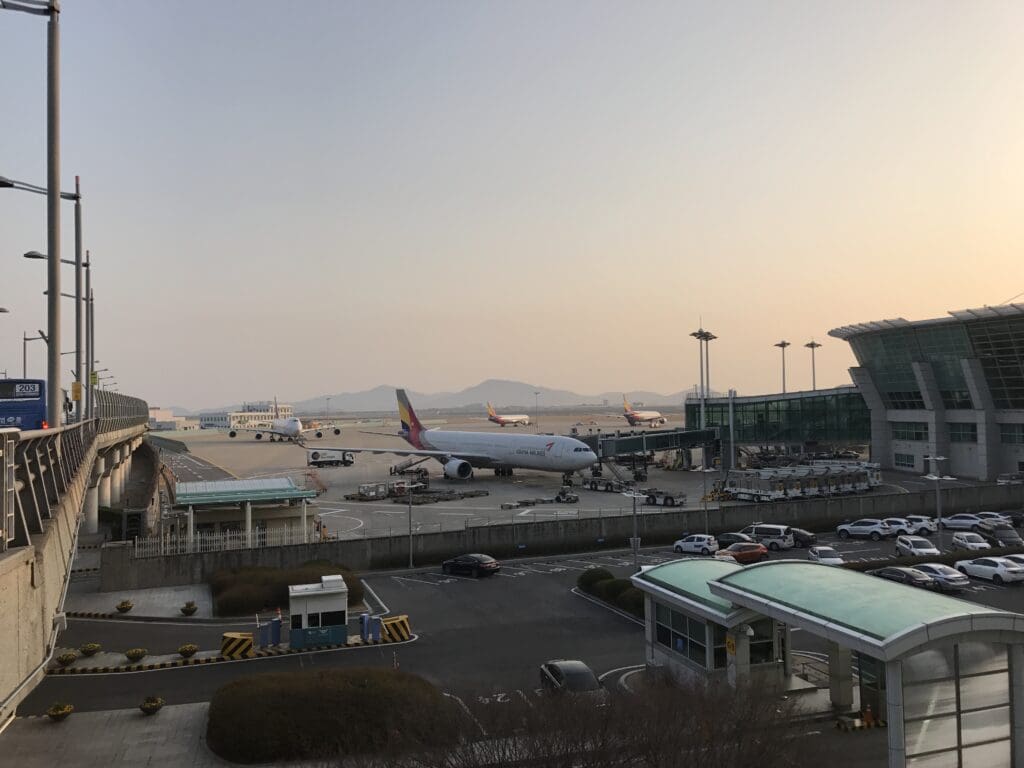
Around three minutes after joining the queue, I was directed towards a desk where I was promptly greeted in English and Korean by an Asiana Airport check-in agent. Once there, my Korean Alien Registration Card, Chinese visa and passport were thoroughly checked before the agent asked whether I wanted a window or an aisle seat and whether I wished to sit in the front or back of the aircraft. After requesting a window seat near the front of the aircraft in the hope that this would mean that I end up near the front of the immigration queue in Yantai, the agent typed away before my Shandong Airlines branded boarding pass was printed off and handed over to me. After being advised that the flight would be departing from the satellite terminal, I was free to continue onwards to security and immigration.
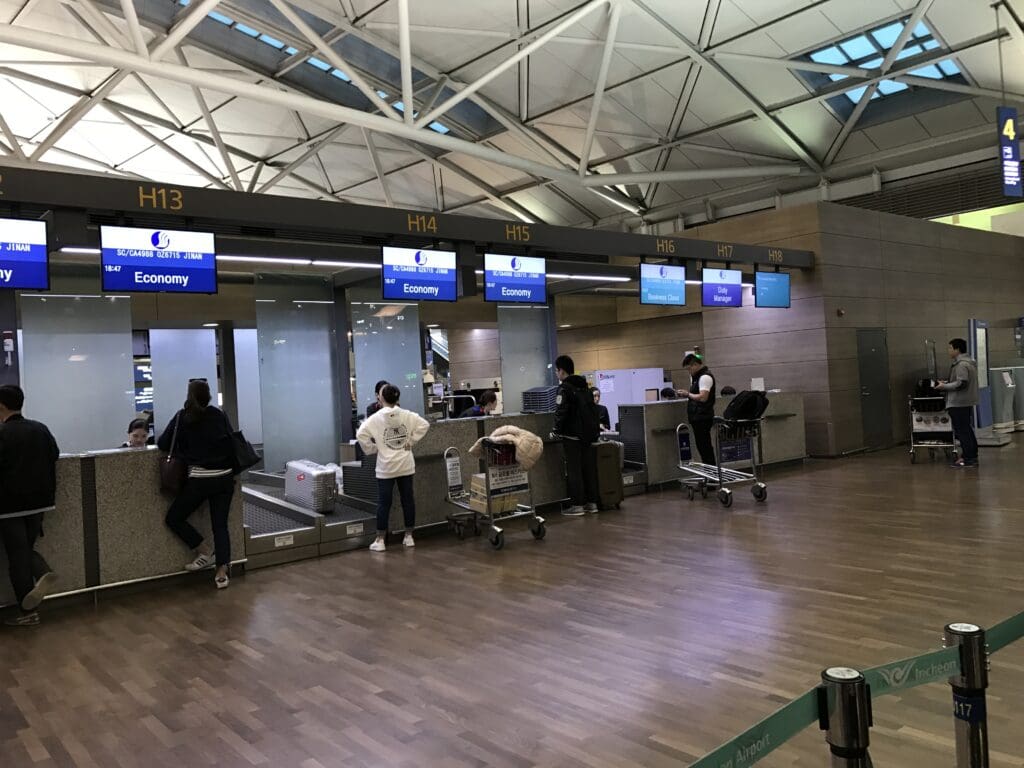
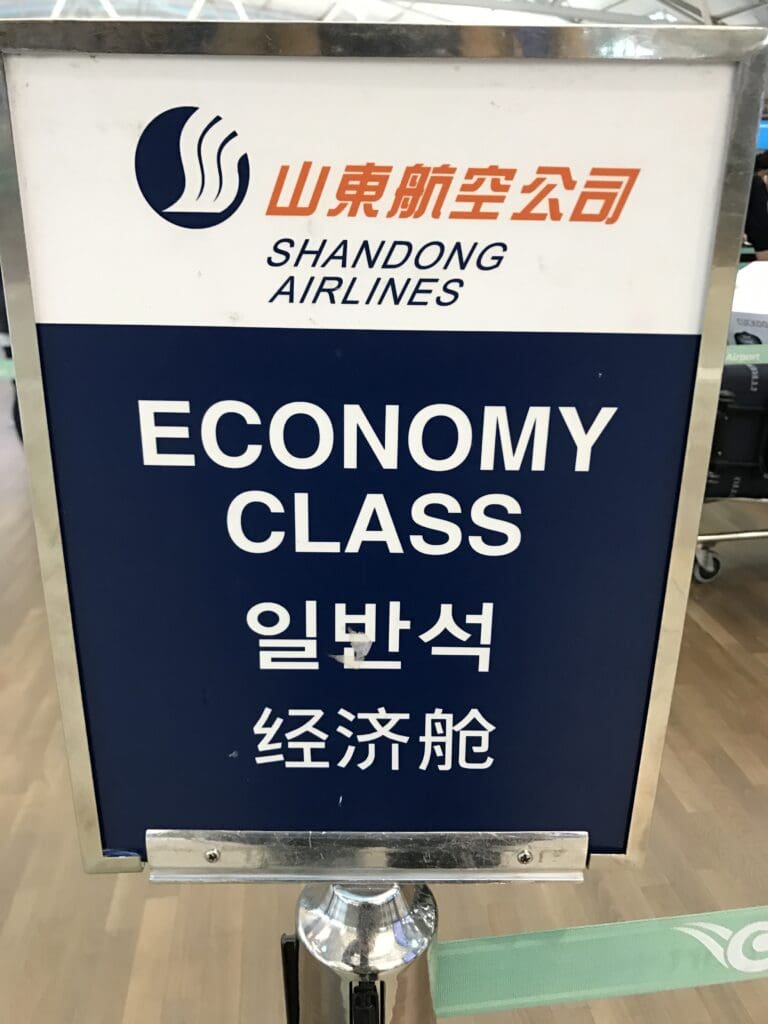
Overall, my check-in experience was quick and easy, and thus incomparable with my check-in experience when flying to Yantai with China Eastern Airlines. However, just as I had noticed back then, most check-in agents were unable to communicate in Mandarin and thus reverted to slowly speaking in English and making hand gestures in an attempt to communicate with Chinese passengers who seemed to make up the majority of the flight’s load. Furthermore, additional problems seemed to be had in the fact that those announcements summoning passengers to the desk whose hold luggage needed to undergo additional checks or have items removed were only undertaken in English. Unfortunately, this seems to be the norm at Incheon Airport, with announcements for flights and missing passengers only ever made in Korean and English, with little consideration for the many passengers who speak neither language.
With my boarding pass in hand, having no reason to remain in the landside portion of the terminal, I made a beeline for the nearest security checkpoint. As I had suspected thanks to the quiet nature of the terminal that evening, this was a breeze and I managed to make it through in no more than five minutes. From there, I steamed onwards to one of the many manned immigration counters, where, without queuing, I was able to hand over my passport and Alien Registration Card to one of the typically stony-faced officials before both were returned to me at which point I was free to head airside.
Seeing as I had little to eat since lunch and being rather sceptical that passengers would be treated to a full meal given the short length of the flight, once airside, I decided to head to one of my favourite eateries in the terminal – a small Korean street food inspired joint that seems to be one of the few eateries that does not sell items with the usual airport markup! Once there, I opted for my usual, what is simply called a ‘hot dog’ in Korea, but, covered in batter, bears little resemblance to the hot dogs that I am familiar with in the UK. These typically contain a sausage sandwiched into a long bun. As I would later discover, these are a novel type of food yet to reach the shores of the UK, an item that North Americans call a ‘corn dog’. After covering this is sugar and ketchup, I carefully ate this as I watched a Korean Air Boeing 747-8 being pushed back away from its stand, commencing its long journey to New York.
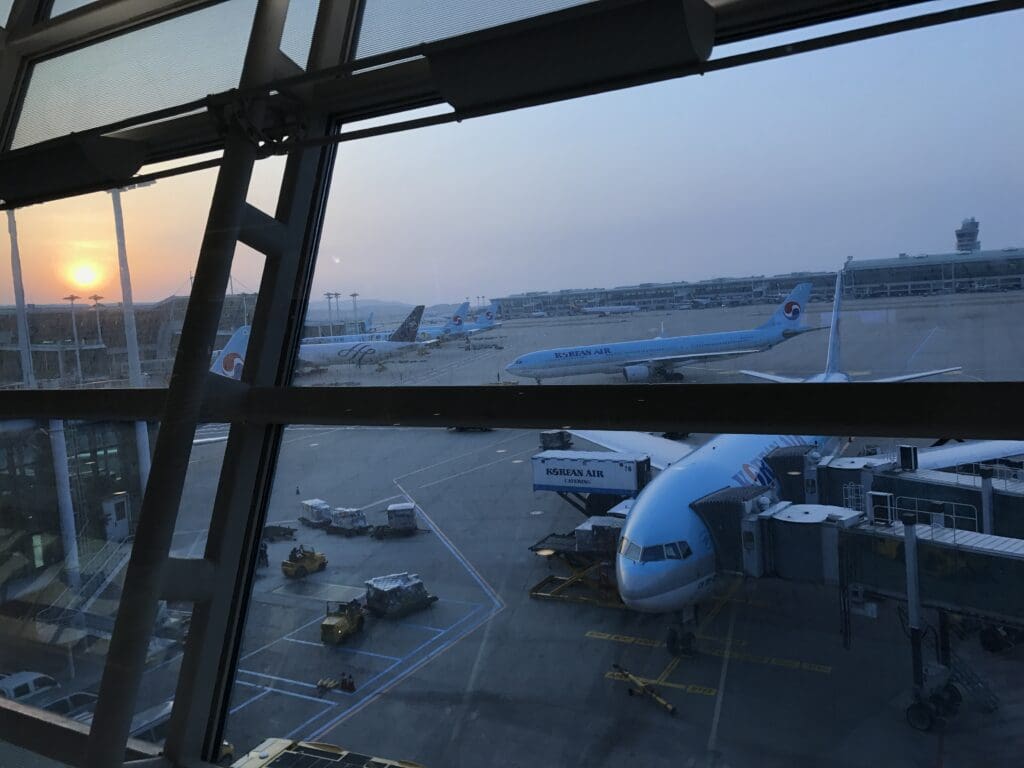
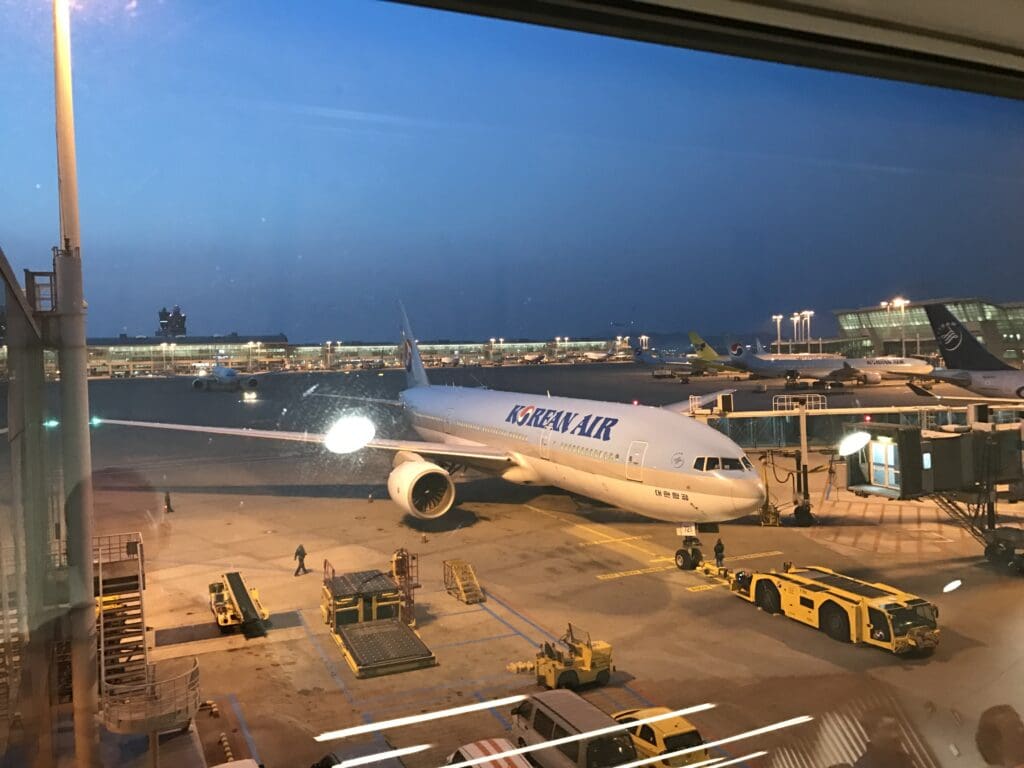
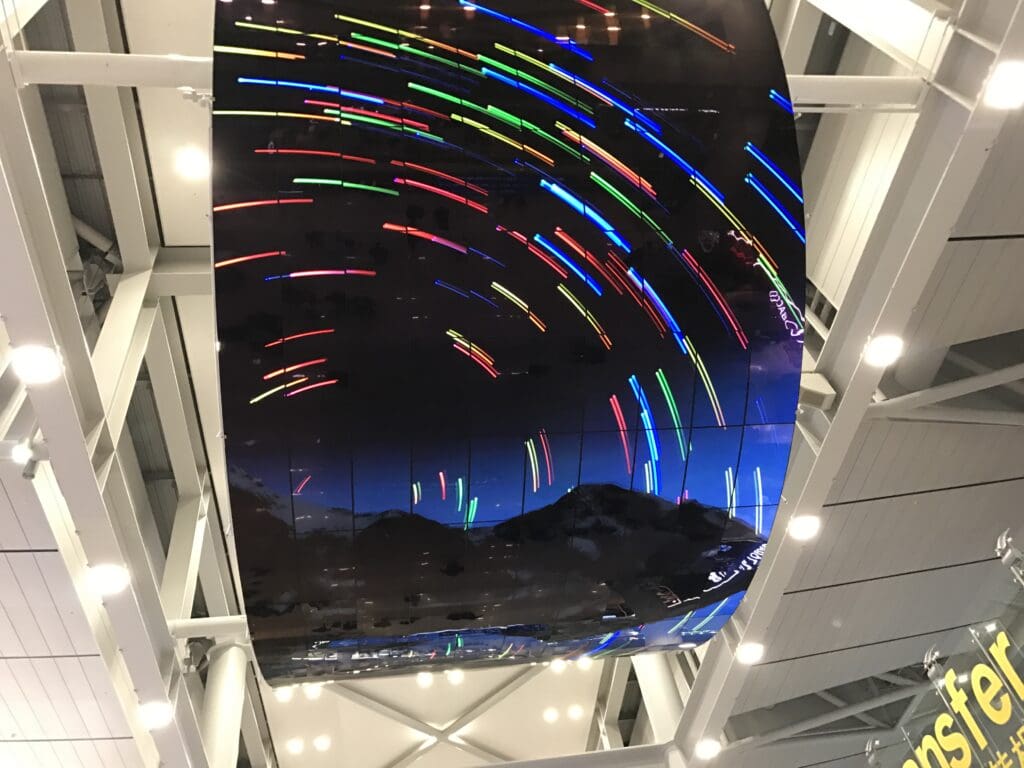

Upon finishing my hot dog, I had a final stroll around the main terminal before making my way down the escalators to the station in order to catch the people mover under the apron to the satellite terminal. Travelling in 2017 and thus before the opening of Incheon Airport’s Terminal 2, at that time, virtually all low cost carriers and airlines from overseas utilised the satellite terminal, and so this was a familiar journey. Following a speedy sprint under the apron, I made my way back up the escalators and arrived at the spacious satellite terminal.
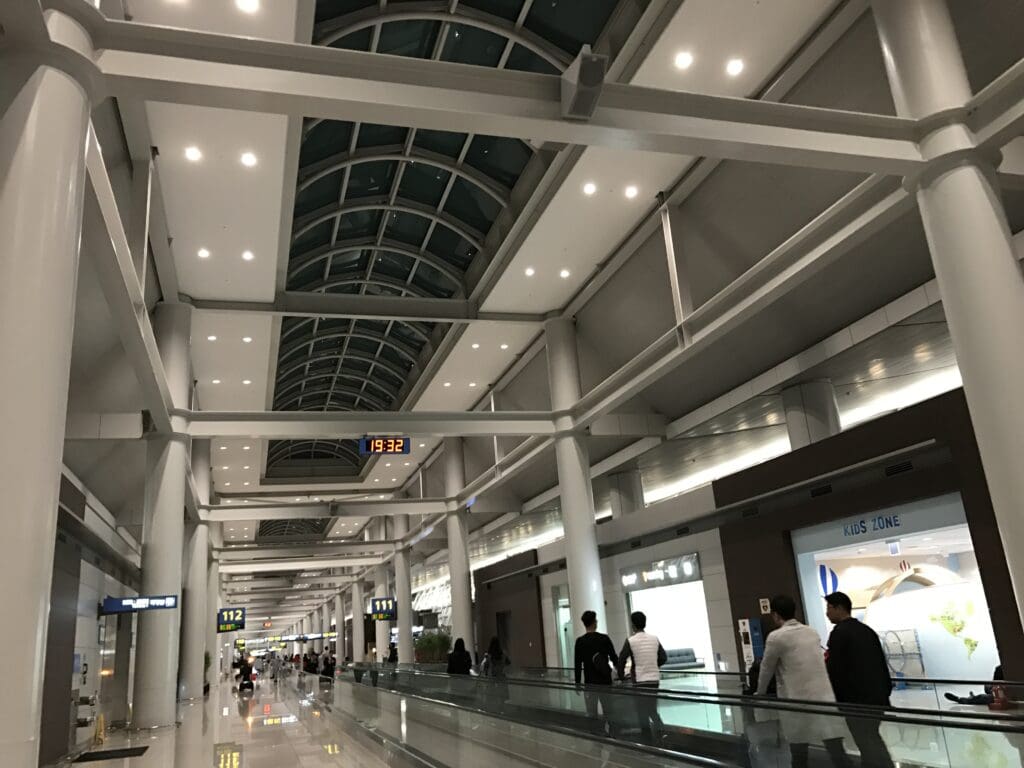
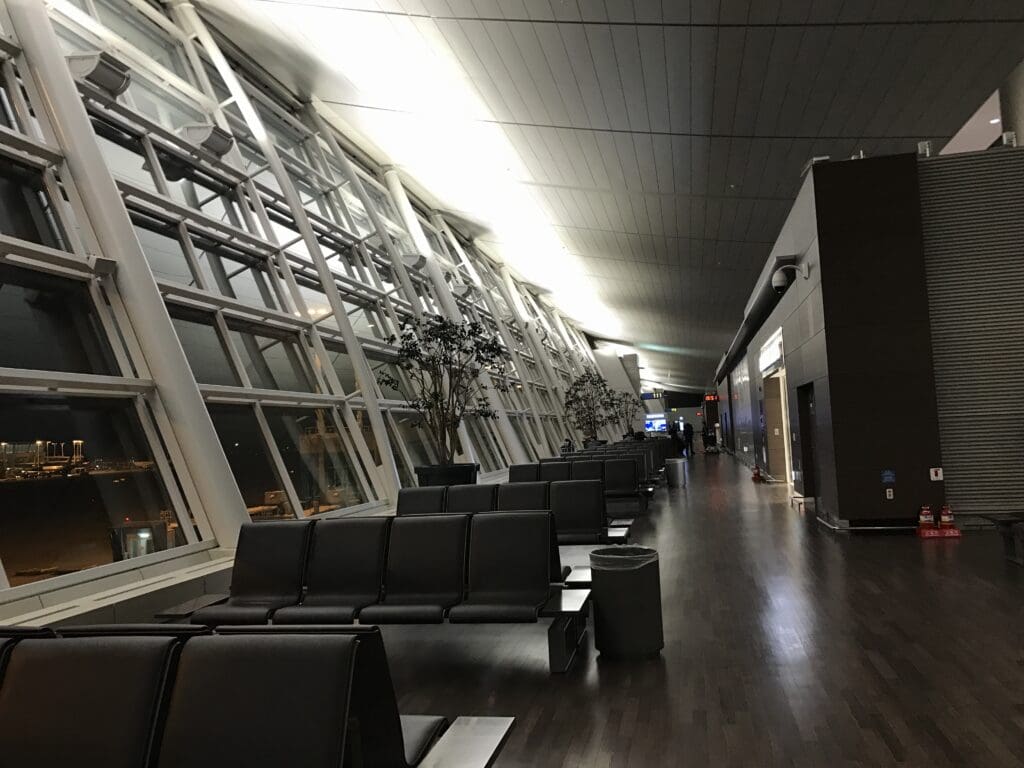
Seeing as my departure time fell after the late afternoon-early evening rush of widebody departures to North America yet before the exodus of overnight flights to the Middle East and Southeast Asia, the satellite terminal appeared to be rather quiet. As is usually the case, there were plenty of places to sit down and the terminal appeared to be spotlessly clean. With little to do, I decided to take a seat and charge my phone whilst browsing the internet using the airport’s free wifi network.
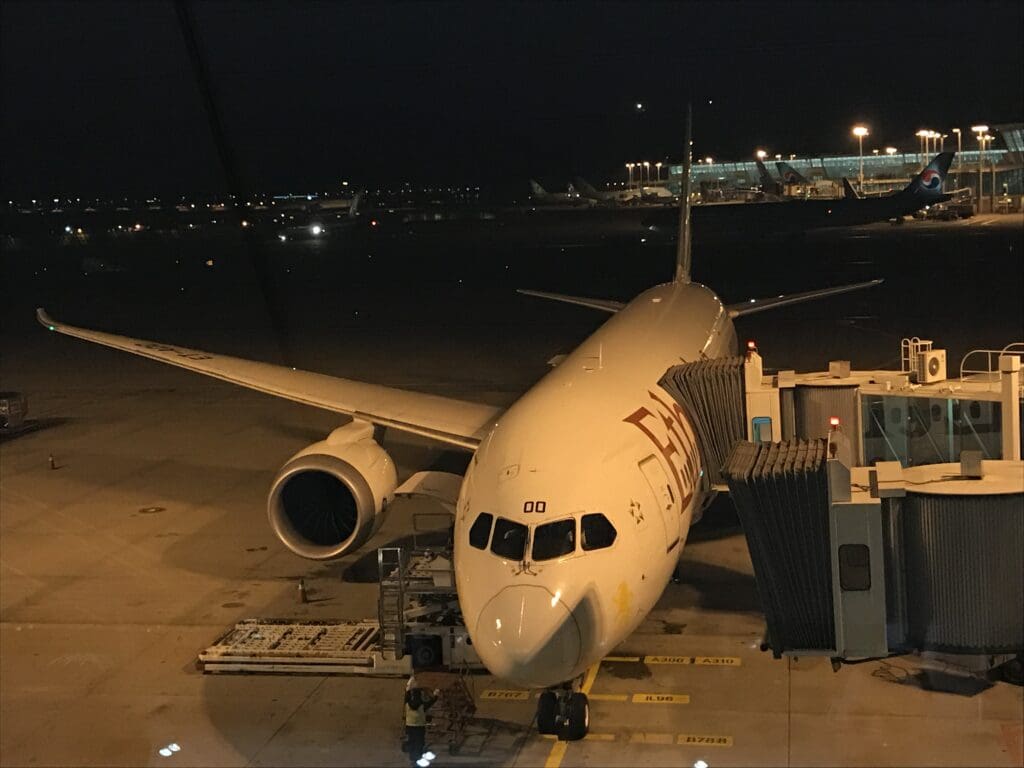
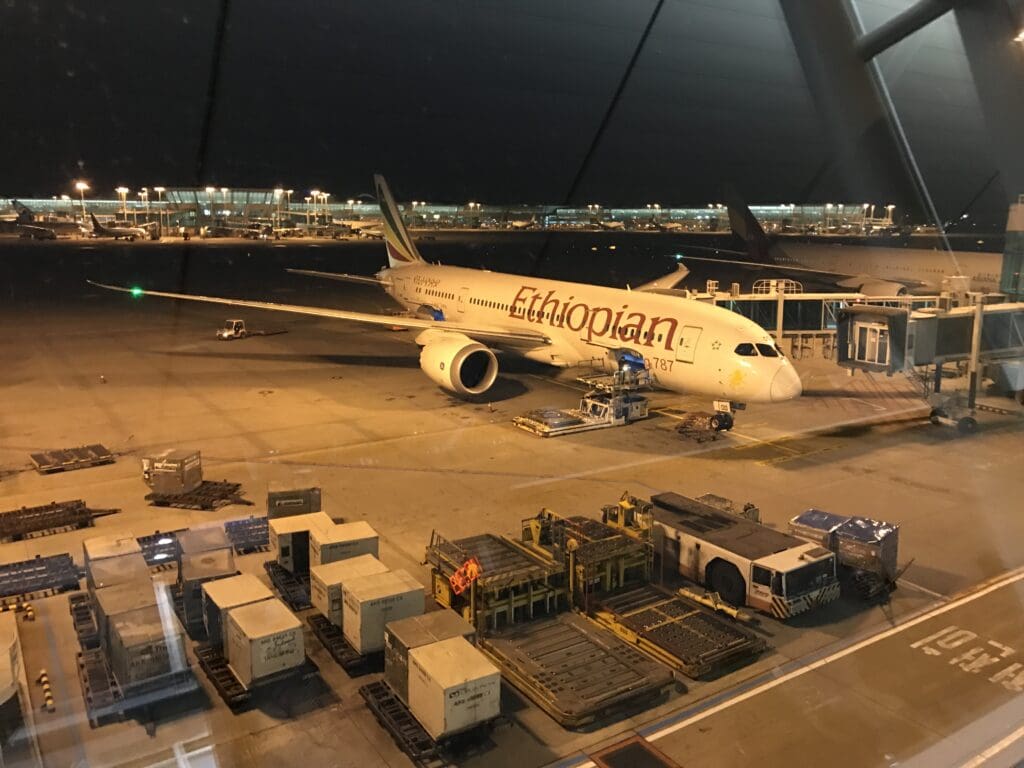
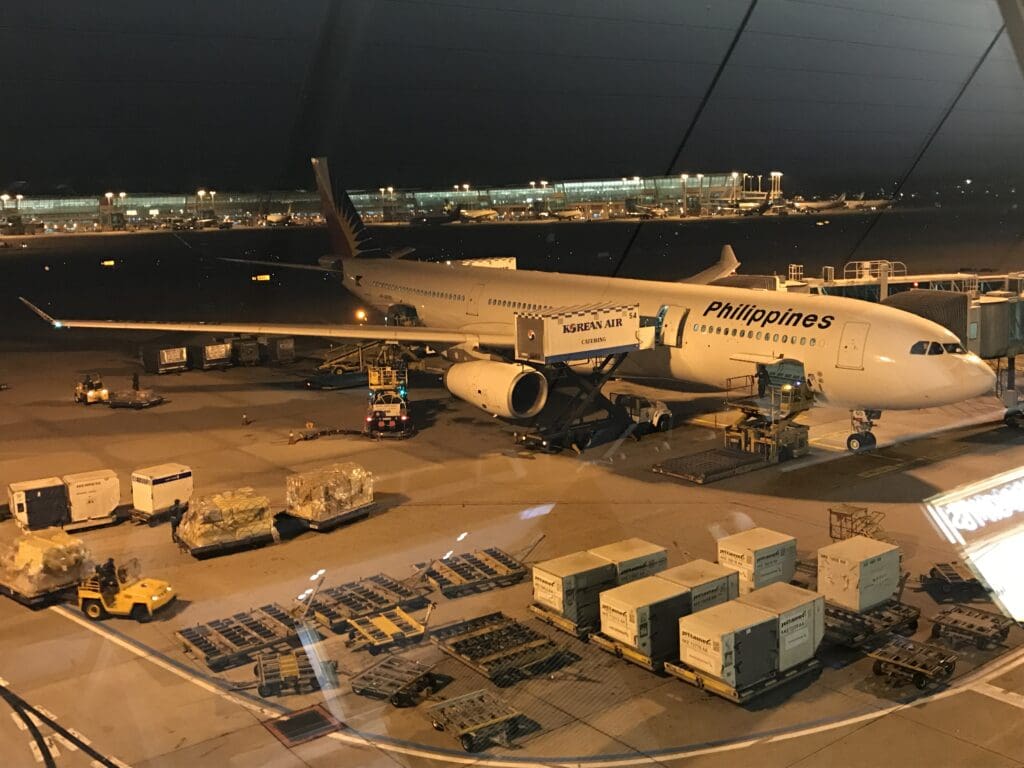
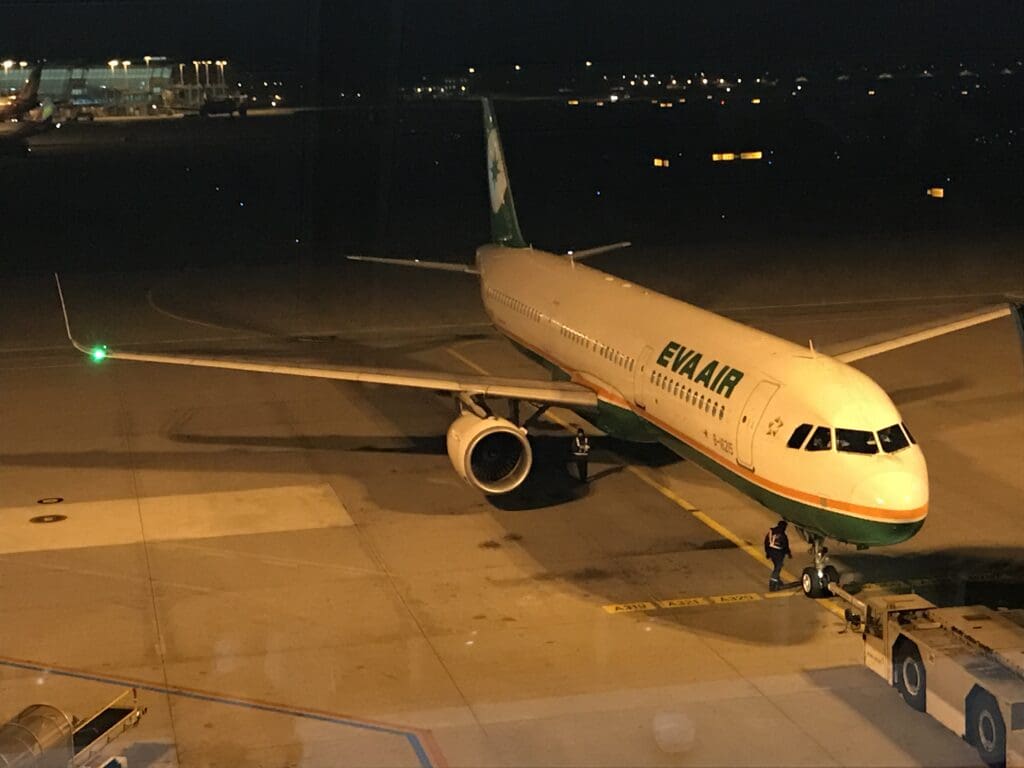
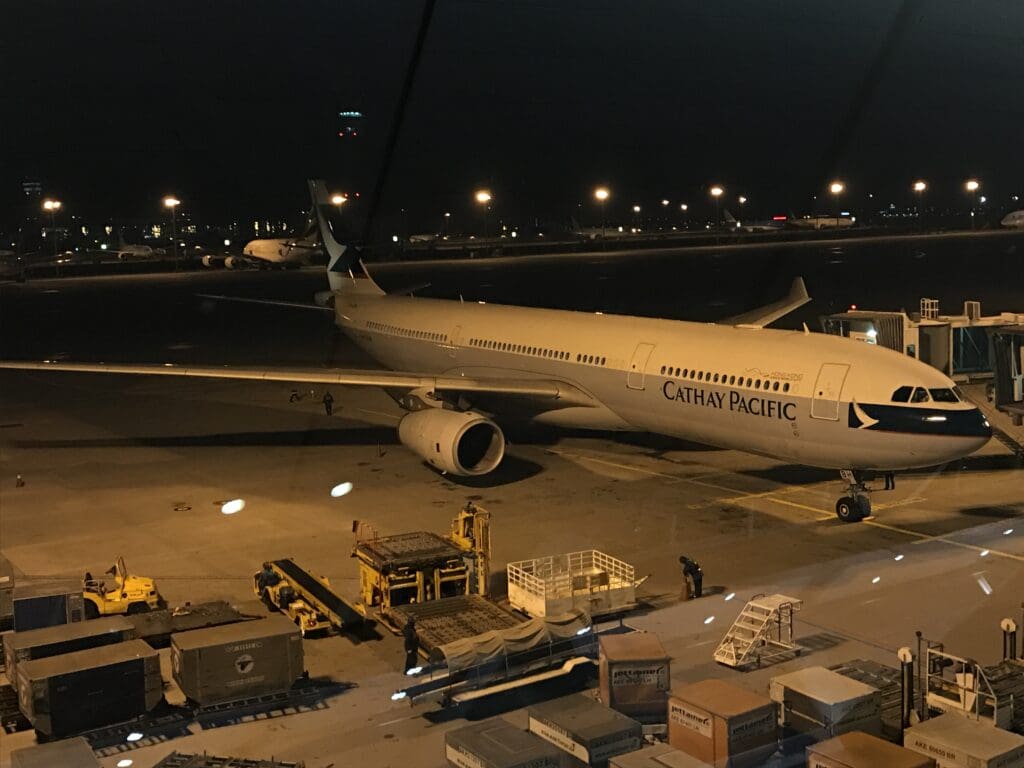
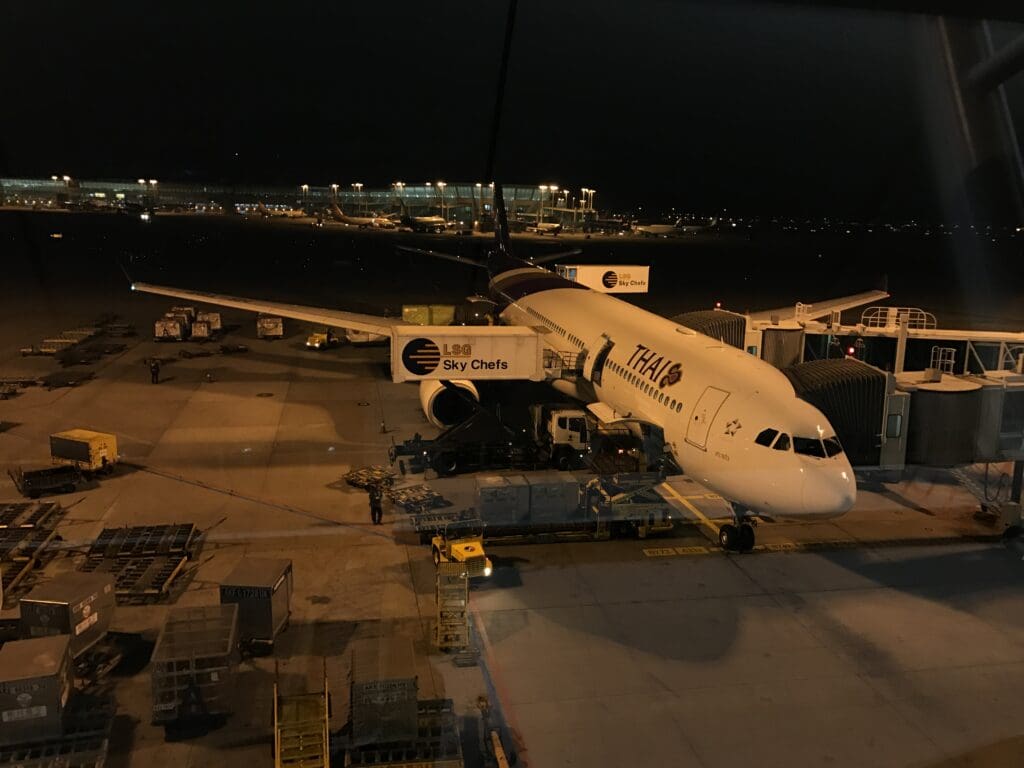
That evening, my flight was to depart from Gate 127 and giving me some hope that we would make an on-time departure, I watched as the inbound Boeing 737 pulled into the stand ahead of schedule after its short hop from Yantai. This particular aircraft came in the form of Boeing 737-85N B-5723. Assembled at Boeing’s Renton plant and with the line number 4311, the jet took to the skies of Washington State for the first time in January 2013, making it a little over four years old at the time of my flight. Following testing, the aircraft was ferried across the Pacific, making stops in Honolulu, Majuro and Saipan before arriving in Jinan. Since then, the aircraft has been deployed across Shandong Airlines’ route network and that evening my flight would be the aircraft’s sixth and final flight of the day having travelled across Eastern China from Yantai to Kunming with a stop in Jinan each way before heading to Incheon. In the past week, the aircraft had travelled at least 17,200 miles visiting Fuzhou, Guilin, Harbin, Incheon, Jinan, Kunming, Nanjing, Yantai and Zhuhai.
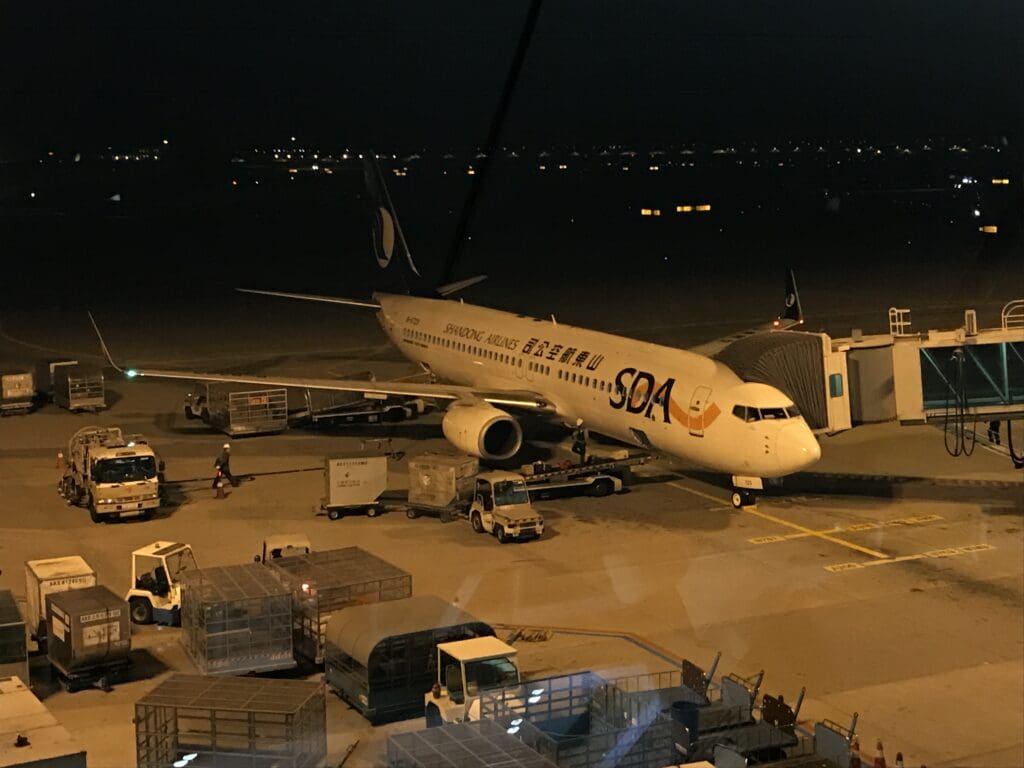
As the flight’s scheduled boarding time approached, the number of passengers at the gate remained relatively low. Those that were there almost exclusively took the form of a group of Chinese late middle-aged men who were glued to the television as this rather appropriately broadcast the live World Cup qualifier China versus Korea football match which would end up being the first time the Chinese team had secured a victory over South Korea!
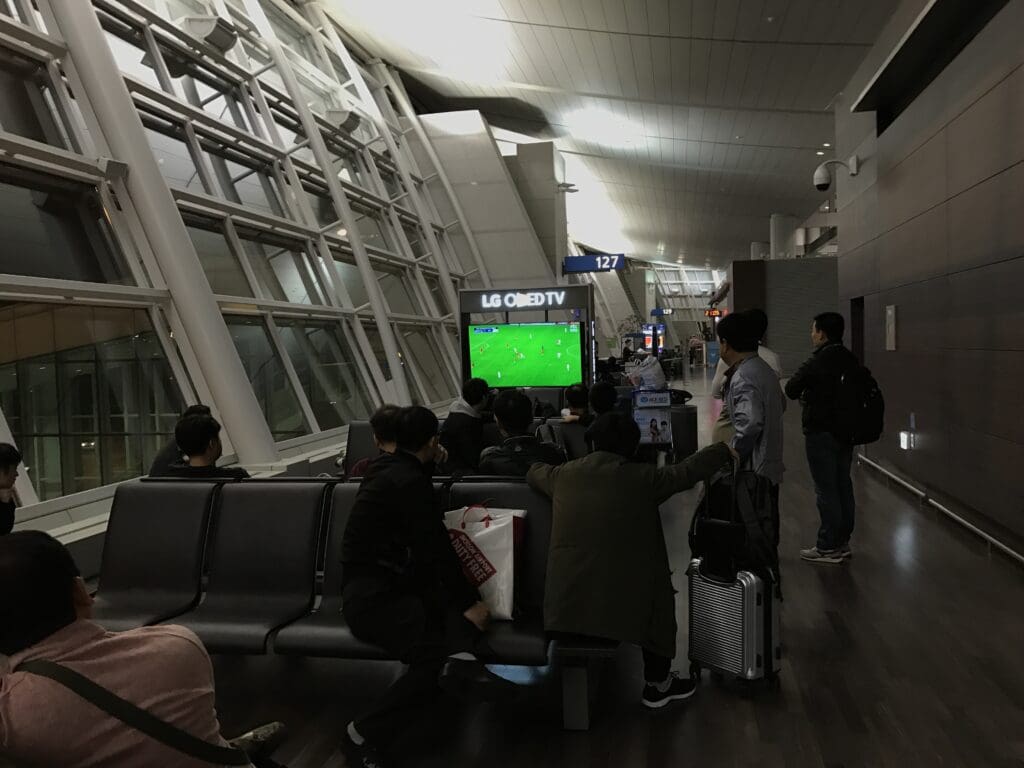
At 2115, an announcement was made in Korean and English inviting those bound for Yantai to board the aircraft. This was not announced in any order, and instead, all passengers were invited to board the aircraft. Joining the short queue, I was soon greeted by a friendly Asiana Airport agent who checked my passport and scanned my boarding pass before I was free to continue onwards to the waiting aircraft. With no queue, I soon stepped into the Boeing’s forward galley where I was greeted in Chinese by one of the six flight attendants onboard who checked my boarding pass before pointing me into the Boeing’s Sky Interior equipped cabin.
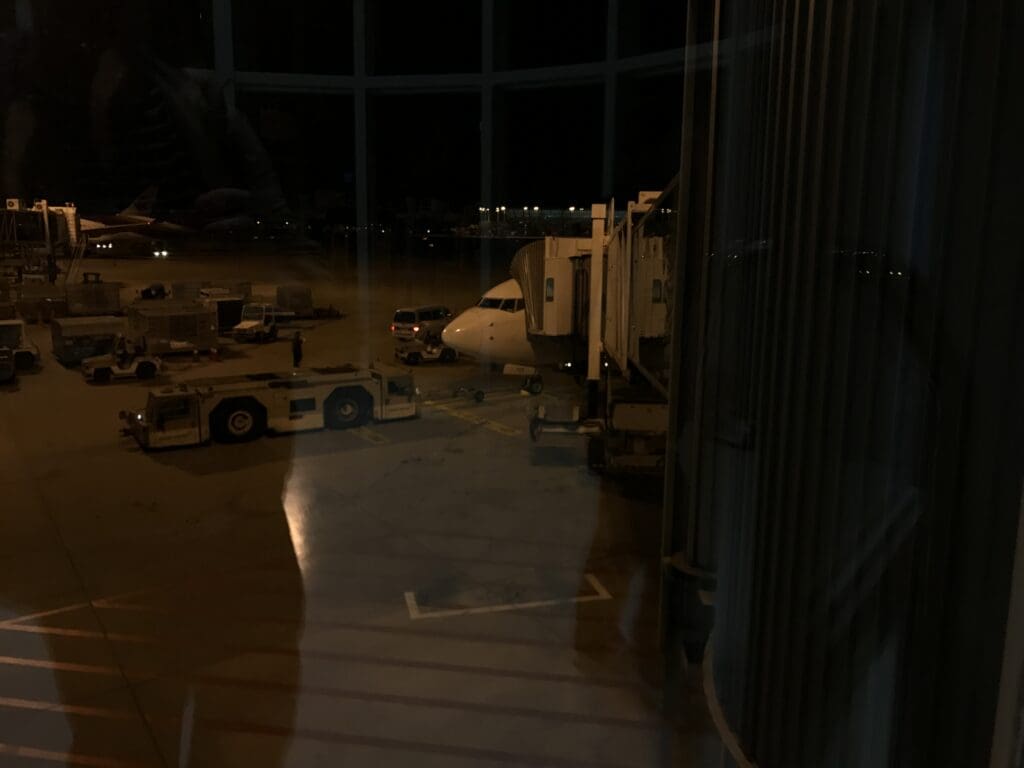
Like most full-service airlines outside of Europe, this particular Boeing featured a ‘real’ Business cabin equipped with two rows of very comfortable-looking recliners in a 2-2 configuration. Each of these was covered in a purple fabric colour, topped with a large adjustable headrest and came with a blanket and pillow. Soon steaming through this, I then arrived in the aircraft’s 160-seat Economy cabin. Adding a nice touch, upon entering this, a flight attendant could be seen with a basket full of sweets which passengers were invited to take as they made their way to their seat. Onboard, each Economy class seat was covered in blue fabric and featured a repeating cloud pattern and a white Shandong Airlines branded fabric headrest cover. As tends to be the norm in China, even on full-service airlines, numerous advertisements could be spotted around the seat. In this case, an advert for the Lunan Pharmaceutical Group could be seen on the back of each headrest cover whilst an upside-down sticker had been placed on the underside of the seatback tray table advertising the city of Qingdao.
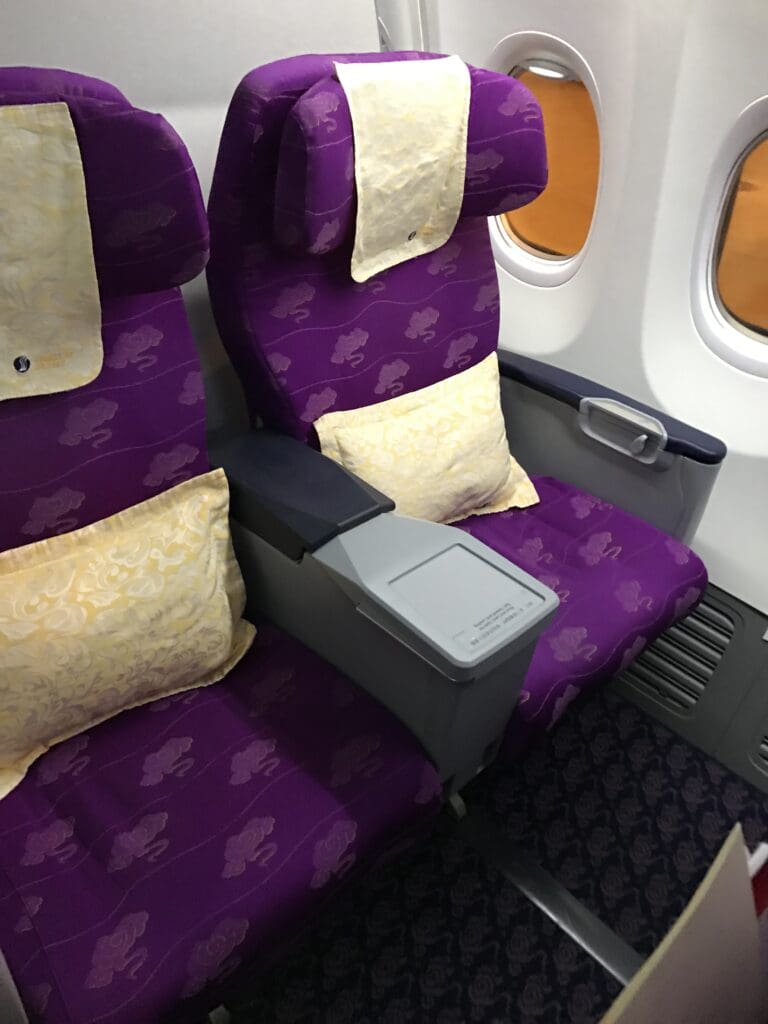
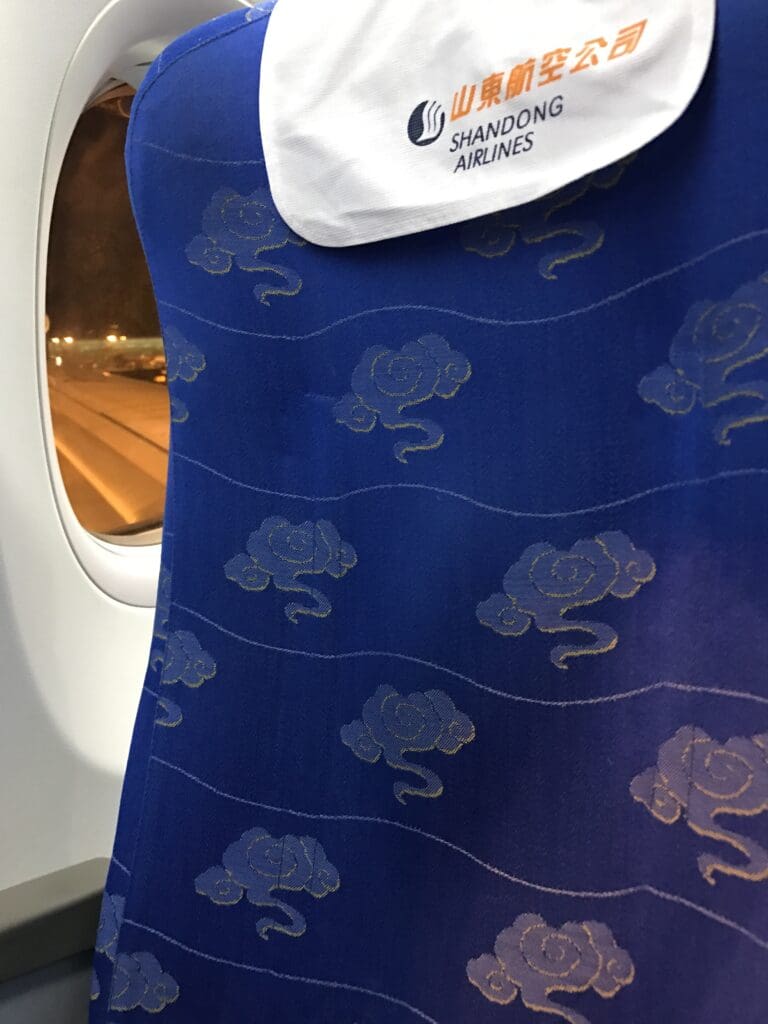
Soon making it to Row 9, I sat down and settled in for the journey ahead. Overall, my first impressions of the seat were positive and I found this to be clean with few signs of wear and tear, whilst the seat itself was comfortable and offered a good amount of legroom. Whilst no major disaster given the short length of the flight to Yantai, I should note that no form of at-seat power was provided, and there were no personal inflight entertainment screens offered either. Turning to the seatback pocket, this contained a safety card, a sick bag and a copy of the Civil Aviation Administration of China’s inflight magazine.

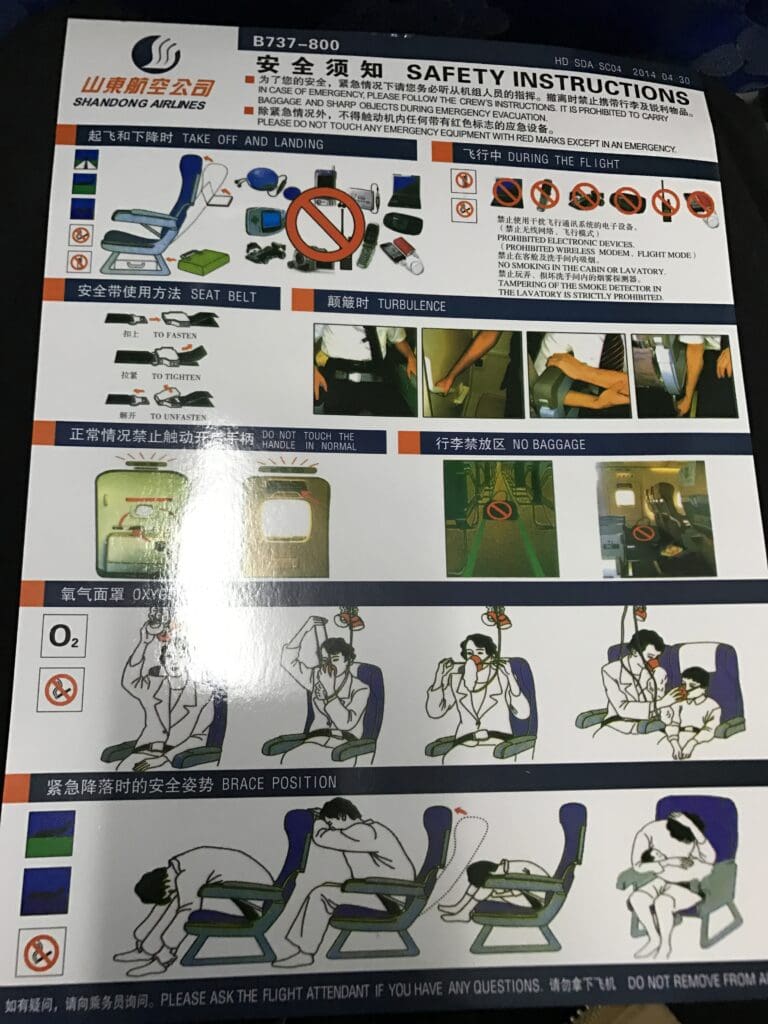
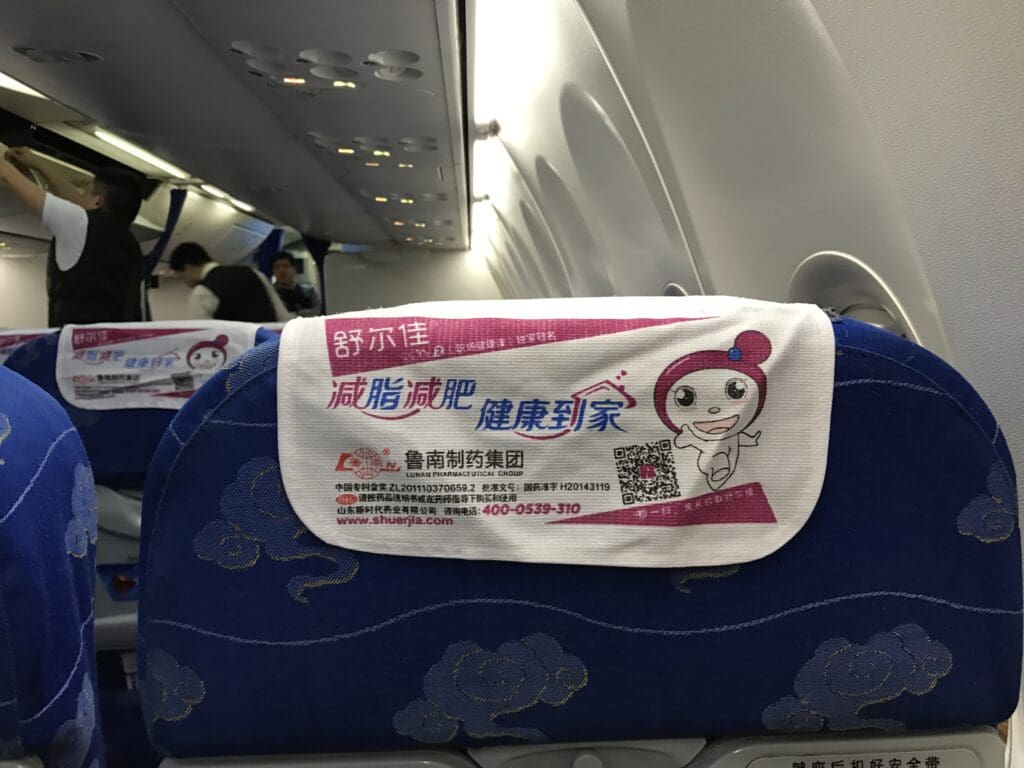
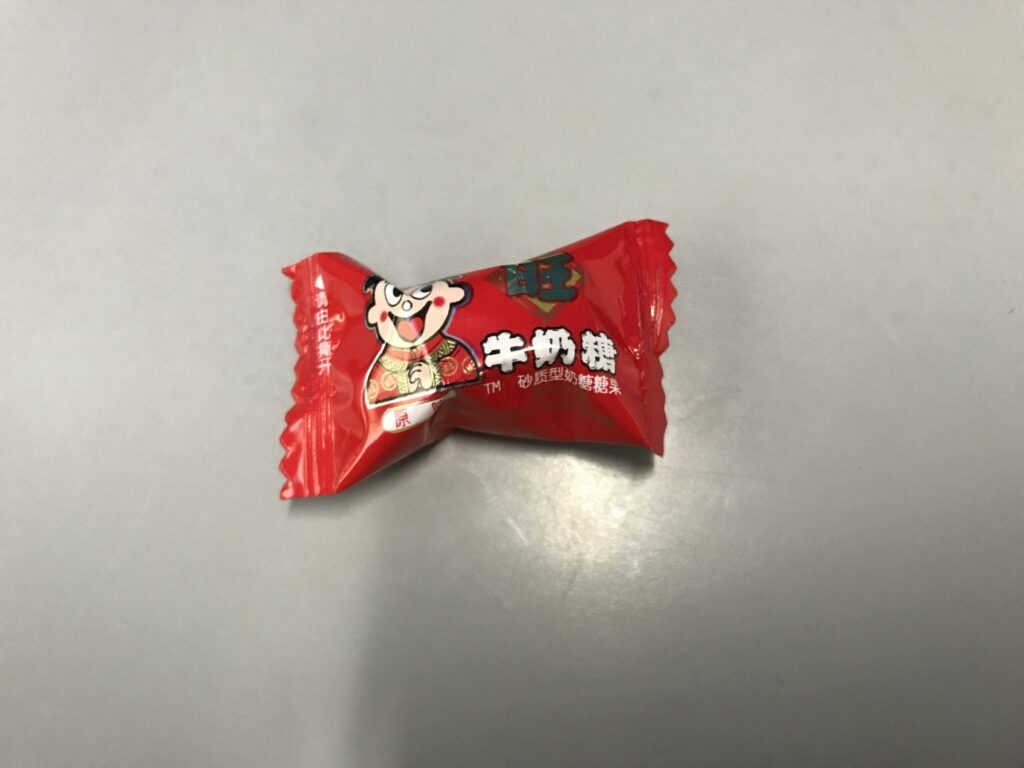
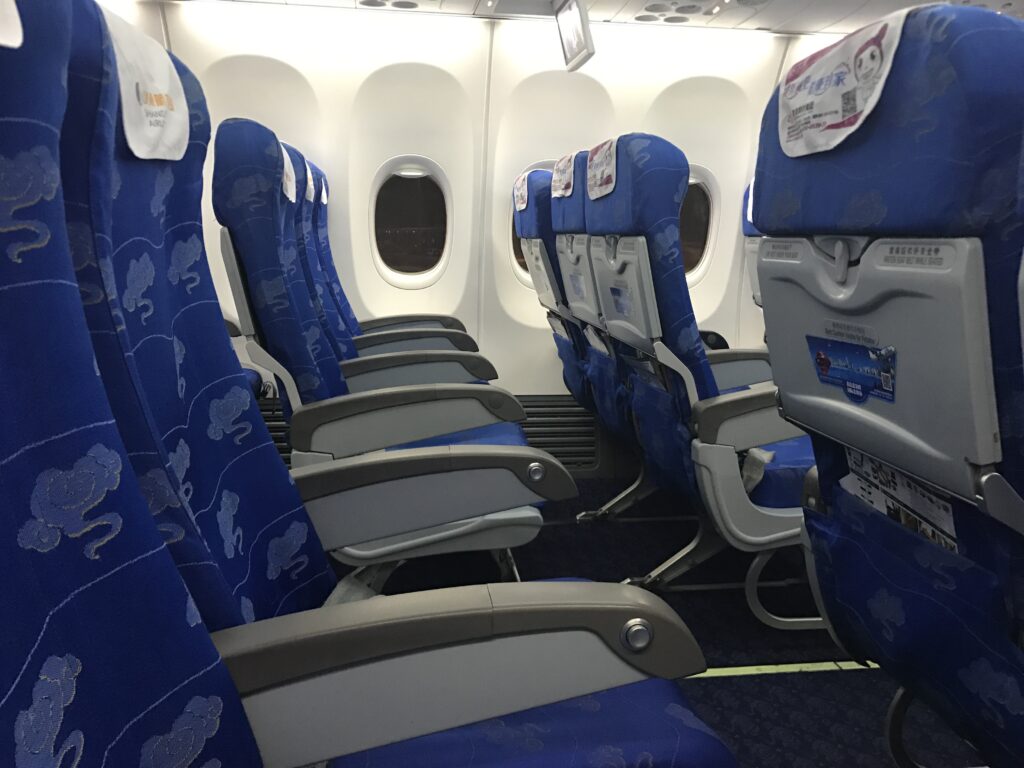
Considering the fact that the China Eastern Airlines Airbus A320 that I had flown to Yantai a month earlier had been completely full, I was somewhat surprised to find that that evening’s Boeing 737 service to Yantai would be fairly quiet. No more than eleven minutes after boarding had commenced, the final straggler had made their way onto the aircraft and I would estimate that the flight was no more than 35% full in Economy, leaving myself and most other solo flyers with a bank of three seats to themselves. That evening, most passengers seemed to come in the form of suited business people, whilst the load appeared to be a fairly even split between Chinese and Korean passengers.
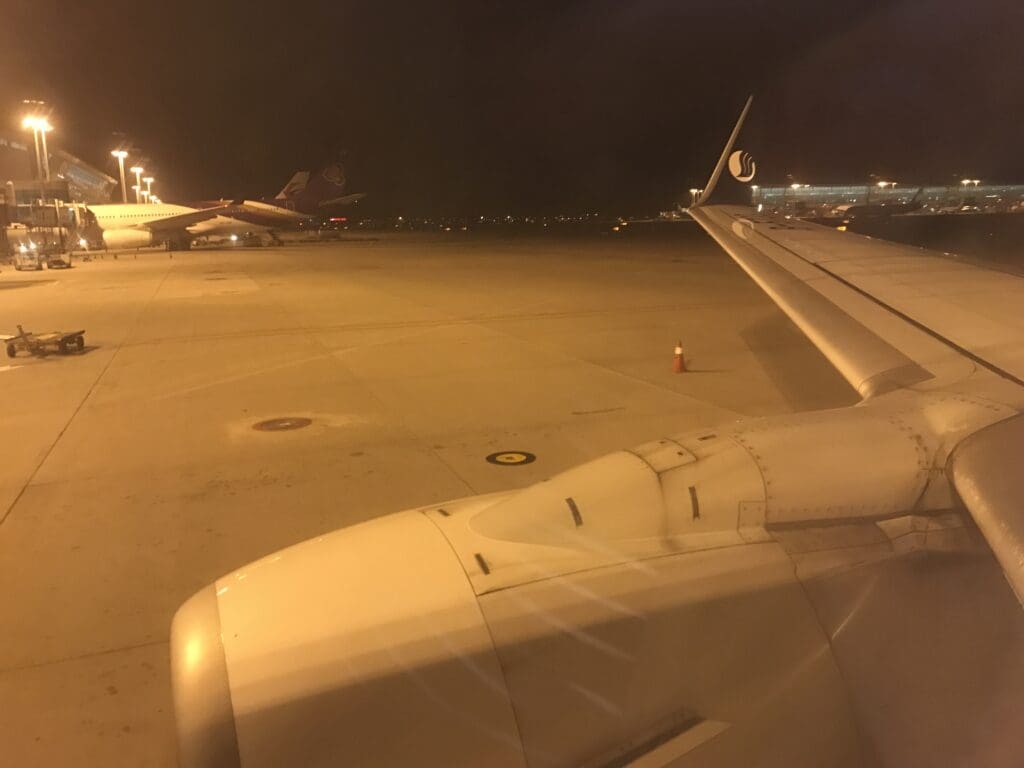
Once all passengers had taken their seats, the cabin door was closed well ahead of our scheduled departure time and without any welcome announcement, the overhead screens dropped down and played Shandong Airlines’ safety video. This was played first in Mandarin with Korean subtitles, before an English version was broadcast as the crew passed through the cabin ensuring that all was secure and in place for our departure. At 2140, the Boeing jolted backwards and began to be pushed back away from the gate. Whilst this was underway, the two CFMI CFM56-7B24 engines began to hum and vibrate as they powered up in preparation to propel us across the Yellow Sea to China that night.. As we pushed back the crew passed through the cabin once more, this time handing out Chinese immigration forms and Shandong Airlines branded pens that could be used to fill these in.
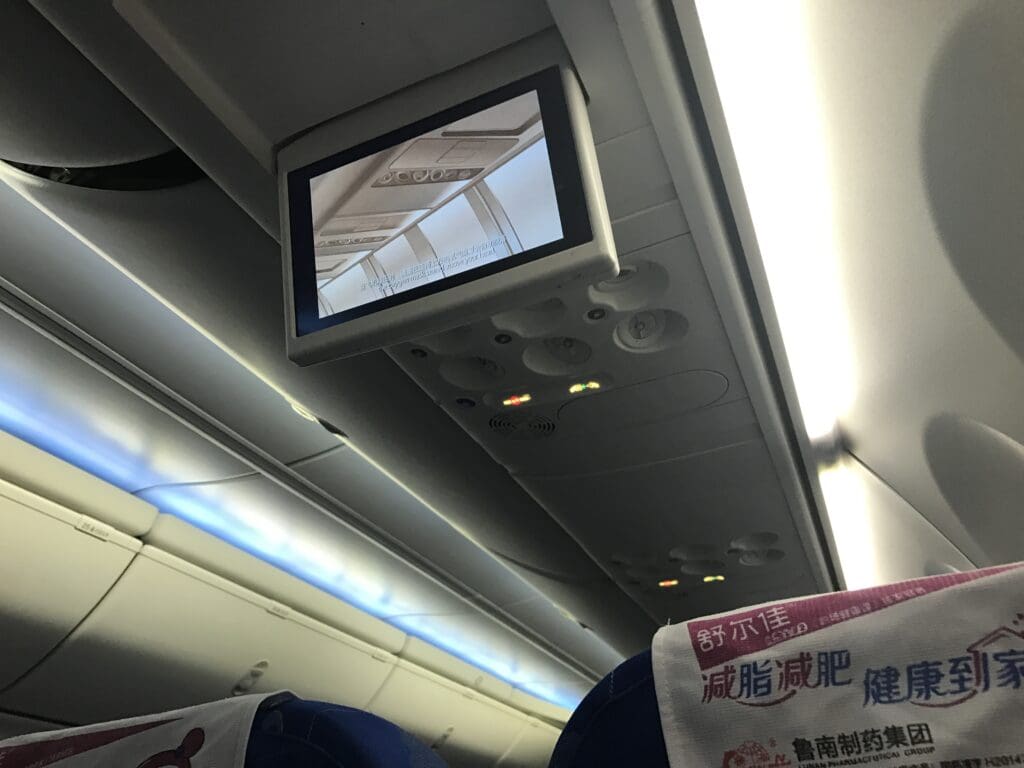
After a few minutes, the two engines had spooled up, the tug had been disconnected and the flaps had been partially extended with a loud whine in preparation for take-off. With all set, the Boeing powered away under its own steam whilst inside the cabin the moodlighting was set to a strong blue tone and we began our journey to Runway 34. Making our way around the terminal, the Boeing soon joined the back of the queue of five aircraft waiting to rocket off into the night.
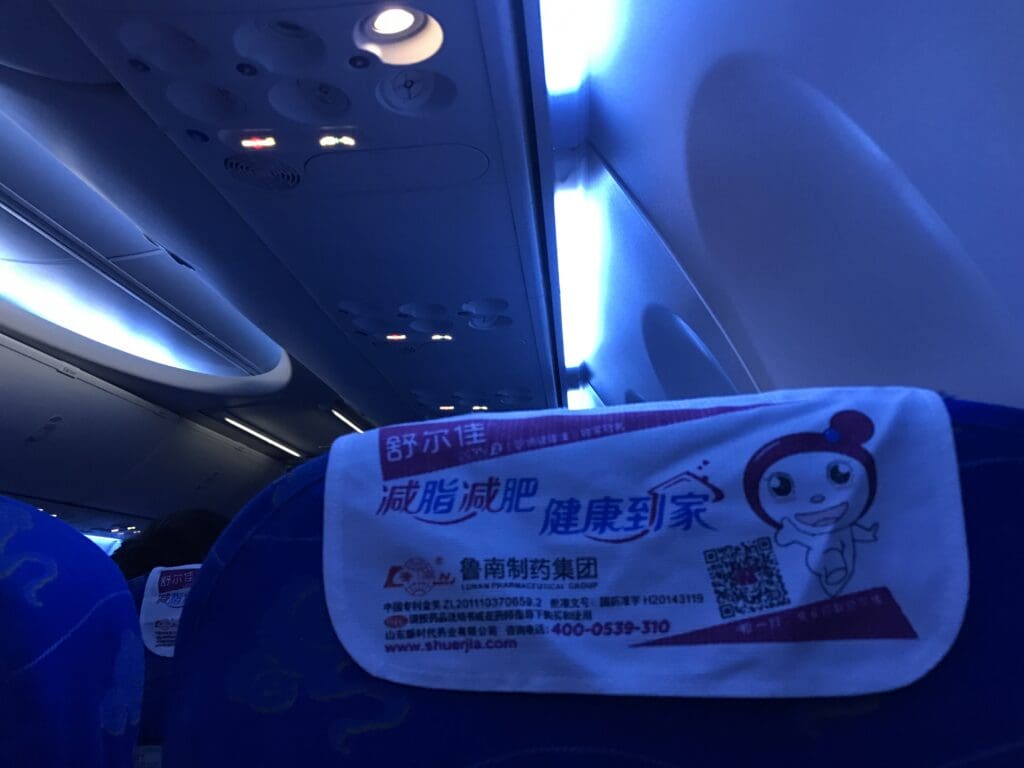
After quite a long wait, at 2200 the Boeing taxied onto the runway before the cabin was filled with noise as we performed a rather powerful take-off roll, soon rocketing upwards into the clear night skies. After less than a minute, the Boeing left the northern shores of Yeongjeong Island behind and we soon turned to fly on a westerly heading to avoid heading into North Korean skies. Following a rather standard departure route for aircraft heading to China, the Boeing flew parallel with the North Korean border for quite some time, however, the lack of lights below meant that other than the odd village, virtually nothing of the country could be seen. I did however spot the lights of the South Korean islands of Yeonpyeong and Baengnyeong.
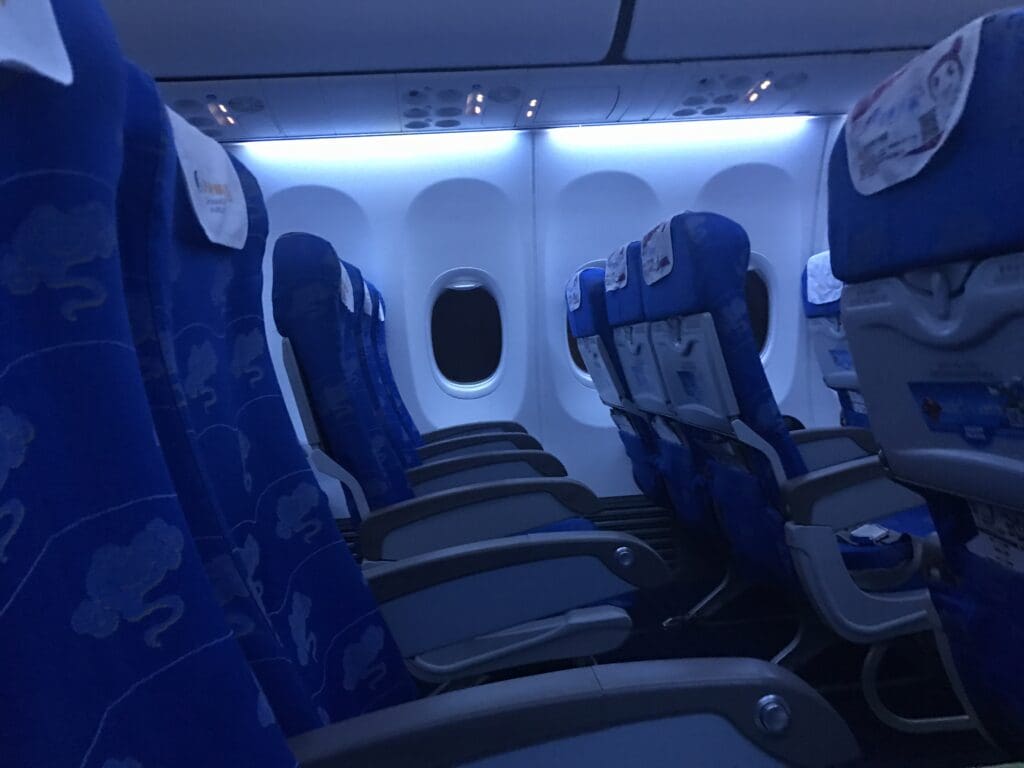
Given the short flight duration, the aircraft cruised at a fairly low 28,000 feet and seemed to reach this in no time. Upon levelling off, the seatbelt signs were extinguished and the intense blue moodlighting transformed to a sandy colour. This was soon followed by an announcement from one of the flight attendants in Mandarin and English which cautioned passengers against behaving badly, and advised all onboard of the soon-to-commence service. A short time later, the Captain’s voice rang through the cabin, thanking passengers for flying with Shandong Airlines and giving a brief overview of the route to Yantai.
That evening, I did not expect all too much in the way of service, although China Eastern Airlines had somewhat surprised me on this route however serving a small snack box alongside a hot bun. Having been pleased with Shandong Airlines’ service thus far into the flight, I had somewhat expected an offering just as good if not better and thus I was a little disappointed to be offered a simple packet of apple chips, a bottle of water and a wet towel with no drink service. Admittedly, the airline did make up for this on the return leg serving a full hot, delicious meal of rice, aubergines and pork mince in a sweet yet oily sauce. However, it ought to be noted that the service was conducted in as friendly a manner as possible and the crew appeared to be proactive in collecting the rubbish of those passengers who had finished during their passage up and down the cabin.
Turning to the entertainment provided onboard the aircraft, unable to understand Chinese, the Civil Aviation Authority of China’s magazine proved to be of little interest, and given the darkness outside, I was unable to rely on aerial sightseeing to keep me occupied during the short flight. The airline does publish an inflight magazine entitled ‘New Air’, copies of which could be found in the seatback pockets during the return leg, although this is published in Chinese only. Thus, the sole form of entertainment came in the form of overhead screens. On the outbound flight, these displayed a moving map, whilst on the return leg an episode of Mr Bean was shown.
Given the short distance that separates Incheon from Yantai, unsurprisingly the Boeing remained its at its cruising altitude for just ten minutes before the Purser undertook an announcement regarding our soon-to-commence descent. This consisted of all the usual warnings regarding seatbelts, window shades, seatbacks and tray tables, and once complete, the sandy toned moodlighting transitioned to blue in preparation for our arrival as we began our journey back to earth. Inside the cabin, one crew member passed through the cabin collecting any rubbish that passengers had accumulated during the flight, before two crew members then passed through the cabin, taking their time to ensure that all was secure and in place for our arrival into Yantai.
As is usually the case when flying on Chinese carriers, the crew members strapped themselves into the jump seats with plenty of time to go until our arrival, and once the final checks had been completed, the overhead screens were retracted and the boarding music filled the cabin once more. Now lacking a moving map to follow the flight’s progress, and thanks to the darkness outside and the fact that we were still over the sea, it was very hard to decipher just how much flight time remained until our arrival into Yantai, with the only clue that we were nearing the airport coming in the form of the whine of the flaps as these extended into position into our arrival. Eventually, the orange glow of the coastal industrial estates of Haitou and Yaqiancun came into view and a very short time later, the Boeing crossed over Yantai Penglai Airport’s perimeter fence before we made a smooth touchdown on Runway 22 at 2154, a grand total of 54 minutes after rocketing away from Incheon Airport.
Once on the ground, the Boeing decelerated rather gently and as a result we sped past the large and modern terminal building, almost making it to the end of the runway before vacating this to the left and commencing our journey to our stand. In the usual manner, once off the runway, the music was replaced by the Purser’s voice as they welcomed all to Yantai in Mandarin and English, thanked passengers for flying with Shandong Airlines and advised passengers to remain seated and buckled up for the time being. Following what seemed to be a fairly slow taxi, the Boeing swung right and cautiously made its way into Stand 107, slotting in between two Shandong Airlines Boeing 737-800s and coming to a halt at 2200, five minutes ahead of schedule.
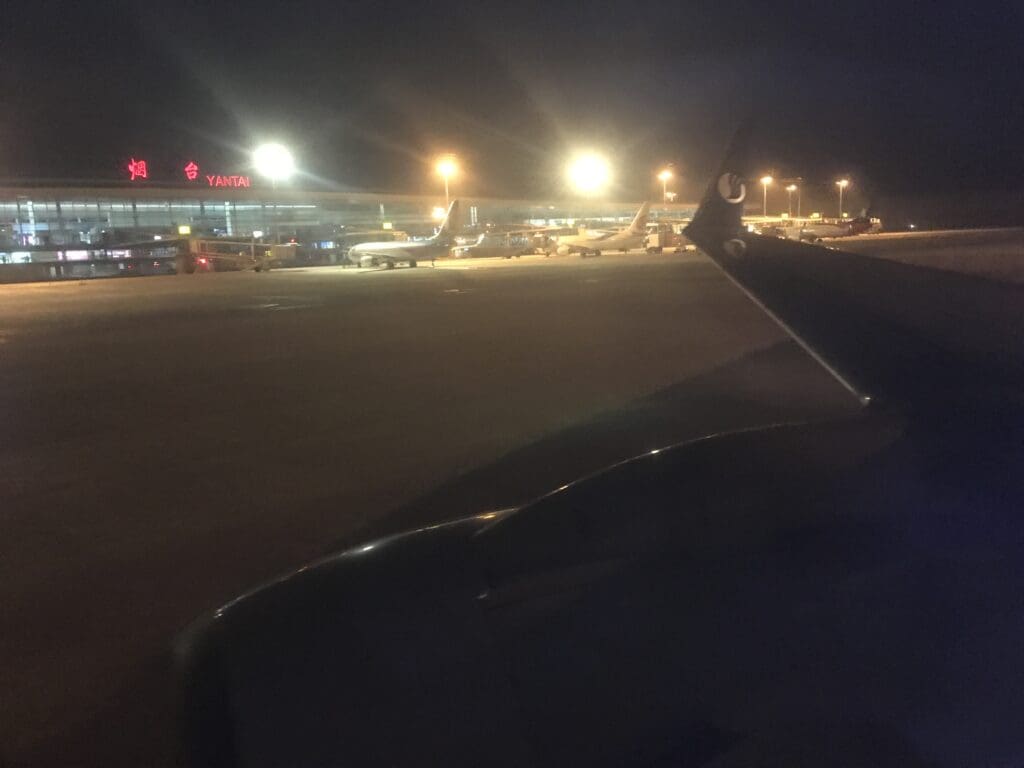
With an army of ground crew on hand and ready to meet the aircraft, once the engines had spooled down it took almost no time for the jetbridge to be connected and for disembarkation to commence. Thanks to the lack of passengers and my position near the front of the aircraft, I was soon able to make it to the forward galley where I thanked the two flight attendants standing there and received a polite farewell in response before I made my way up the very cold jetway and entered the terminal.
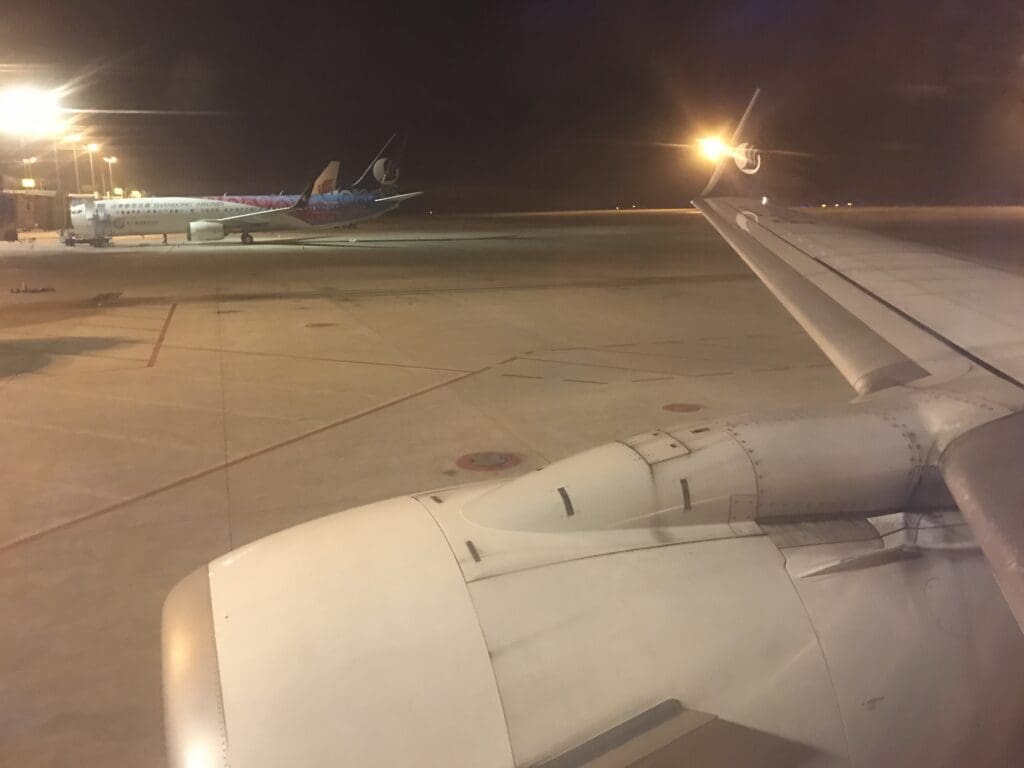
Upon reaching the terminal building, passengers were greeted by two signs, one for domestic arrivals and another for connections, whilst a stream of passengers who had arrived on a flight from Shanghai Pudong could be seen making their way to the domestic arrivals area. Ultimately, it seemed that there had been some failure here as international passengers were now mixing with domestic ones and there was little to stop those who had arrived from Seoul from entering China without any immigration check! Within a few seconds, a rather panicked airport worker shouted in Mandarin, which I assume was an instruction for passengers that had arrived from Seoul to head in the opposite direction to domestic arrivals. Following their command, I soon reached the door that leads to the airport’s immigration checkpoint, however, once there, I found this door to be locked. Eventually, after a few minutes, an airport worker came and unlocked the door, with all of this fiasco leading me to believe that the airport was not prepared for an international arrival at that time! Being one of the first passengers to arrive at immigration and not having to fill out an immigration form, entering China was quick and easy, and by 2215, ten minutes after our scheduled arrival time, I was landside and headed out into the chilly night air for the short walk to the airport’s onsite hotel.
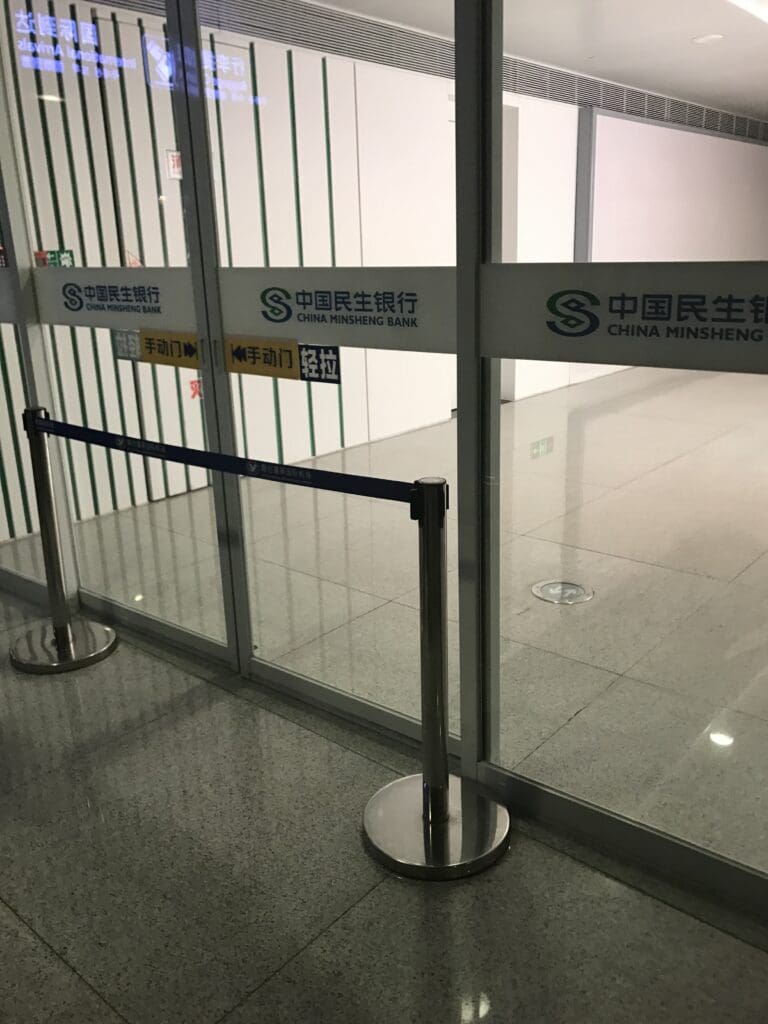
Summary
Whilst Shandong Airlines is a rather large airline, its limited operations abroad (especially outside of East Asia) and the unfriendly nature of its website for non-Chinese speakers ensures that outside of China, the airline remains rather unknown. With English and Korean language reviews of Shandong Airlines being somewhat hard to come by, I was unsure of what to expect from the carrier. As it turned out, I was pleasantly surprised. The aircraft was comfortable and its interior was in tip-top condition, the crew were pleasant, polite and far friendlier than the crews that I had encountered on China Eastern Airlines and China Southern Airlines. Whilst I may have been a little disappointed at the lack of any substantial offering on the outbound flight, I expect that given the flight’s departure time, the airline would have likely expected passengers to eat before the flight and I can thus understand the airline’s rationalte for not offering anything more than a bag of apple chips and a bottle of water. I should also note that a small hot meal was served on the return flight to Seoul. To summarise, I had a rather positive experience with Shandong Airlines and, after my short two flights with the airline, I would most definitely not hesitate to book a longer flight with the carrier.

